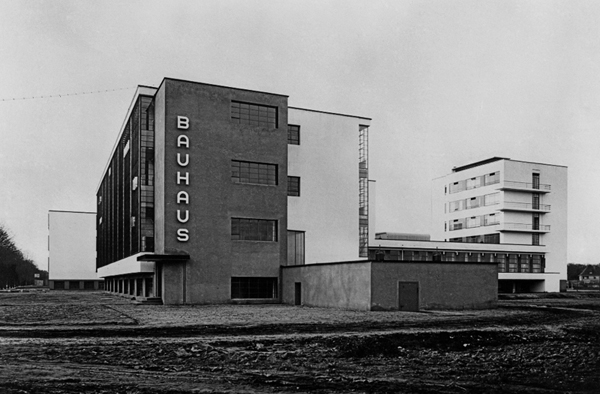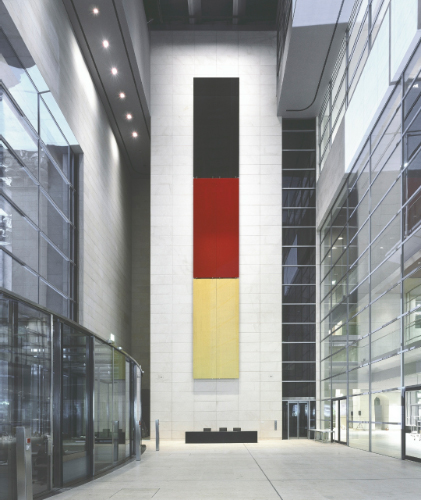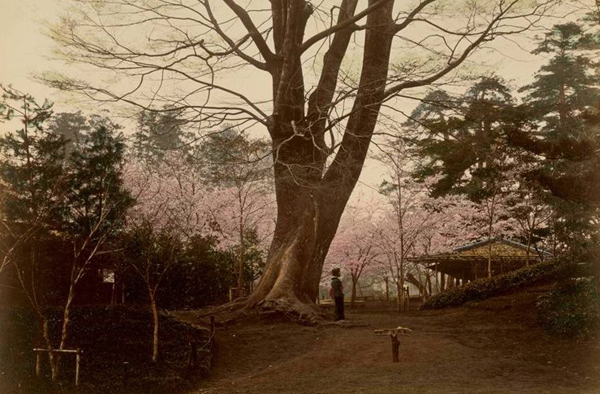In The Meantime: A Playroom of My Own #10
Yuko Otomo
March 2016
Autumn in Europe
Part Two
Germany
 Lucia Moholy’s Bauhaus building in Dessau. Photograph: © Lucia Moholy/Mima
Lucia Moholy’s Bauhaus building in Dessau. Photograph: © Lucia Moholy/Mima
Berlin:
The Berlin Wall & the Holocaust Memorial
Jürgen (Schneider), Steve & I walked in a cold rain following footsteps of the dark history of this city. This history does not belong to a remote past, but to “our” time. All of our parents had gone though the war, & we came right after it. As the first post-WWII generation: Jürgen in Germany, Steve in the U.S. & myself in Japan; we were born & grew up in the scarred reality of that world, each sharing this same period with different contents, background psychologies, memories, environments & circumstances.
I’ve never read Berlin Alexandreplatz by Döblin, but I have seen a great cinematic work by Fassbinder based on this book. So, the idea of being in Alexandreplatz stimulated my imagination. Steve felt the same. But the reality of the platz was just a haphazardly constructed, typical postwar public space. Jürgen pointed at one of the remaining Bauhaus buildings that had survived the devastation of the city. What an insanely maddening event WWII was! Every major nation was trying to demolish the enemy nation to rubbles to wipe out its history & everything else. Being in Berlin was one of the most psychologically, emotionally & intellectually traumatic experiences I’ve gone through. Too many layers of the city’s historical elements, mostly dark & inconsolable, make me lost as to how to feel & how to think.
The wall was pathetically low, primitive & hand-made. It was not horror that got me, but the stupidity of the whole thing: its concept & actualization. The shabbiness of the watchtowers made it impossible to envision the time when people were getting killed crossing the dividing line. The symbol of the Cold War: the continuous wall of horizontally standing concrete & steel, breaking the city into two, ran like a river through it. My expectation of seeing a straight dividing line was betrayed by the reality of a winding, irregularly curved line. It was totally absurd to realize that it had been up until very recently & had only come down in 1989. This wall was our event, a reality of our time, not a thing of the past. I still remember my childhood when we were told to believe that the wall was eternal. Now its small surviving fragments exist, preserved & protected, as national monuments. It’s one of the most popular tourist attractions of the city & people take souvenir photos with the wall as a background. What heartbreaking, absurd horror & irony!
The Holocaust Memorial site was a rectangular square filled with abstract square stones with different heights & sizes. It’s a forest of a maze made out of 2,711 dense, slate gray, graffiti-proof concrete memorial stones. Once you walk in, you get lost. Done with a minimalist sensitivity, with no names chiseled on any of them, death is totally anonymous here. For some reason, the anonymity of death that the memorial presented disturbed me deeply. The forced deaths of this tragedy were never anonymous. It was clearly & recognizably very personal & there. I was overtaken with ambivalent emotion.
 Gerhard Richter, Schwarz, Rot, Gold, 1992 Deutscher Bundestag
Gerhard Richter, Schwarz, Rot, Gold, 1992 Deutscher Bundestag
Steve tried to find some “pebbles” to place on top of the stones as offerings to the dead souls according to Jewish tradition. But it was almost impossible to find one, since the whole area was paved. Steve managed to find tiny fragments of broken pavement & placed them on top of some stones. We were told that Hitler’s bunker was located somewhere close by. Like the wall, the memorial site is now one of the most popular tourist attractions. Souvenir shops sell postcards & a pizzeria serves food & drink to people. We walked further to the Brandenburg Gate & then to the Reichstag. We had no time to go inside the building that Steve claimed was “the place where my people’s destiny was decided.” Jürgen told us that Gerhard Richter’s painting hangs in the hall now.
Hitler’s personal madness & the general human tendency & weakness to blindly follow a leader’s orders jointly committed this unforgivable, monstrous crime beyond words. It was impossible to be in this city without thinking of the darkness of Weimar & the atrocity of the Nazi era as well as the following Cold-War tragedy of East vs. West. The history of this city carries the history of darkness pulling its own shadow into further darkness. Oh, madness of war & madness of territorial ambitions! The meaningless emptiness of the aftermath is left all around us, filled with unending, painful, destructive memories.
 Fotograf unbekannt: Tōkyō, Gartenlandschaft mit Geisha, um 1885, Albuminpapier, koloriert
Fotograf unbekannt: Tōkyō, Gartenlandschaft mit Geisha, um 1885, Albuminpapier, koloriert
© Staatsbibliothek zu Berlin – Preußischer Kulturbesitz
Zartrose Und Lichtblau: Japanese Photography of the Meiji Era 1868-1912 @ Museum for Photography
I highly anticipated this show, naturally, & I was well rewarded. It was a remarkable show, well organized & well presented. How fascinating it was for me to realize that the dawning of Japanese Photography coincided with the dawning of the new Japan! Witnessing images of the old & the new Japan in these photo images was a deeply moving experience. Meiji-Ishin; Meiji Restoration. Japan opened its door to the rest of the world in 1868, ending the isolationism that had been set in 1635. The Edo Era & its feudal Shogunate society that had lasted since 1603 was abruptly forced to end, & the Meiji era started with the sudden Westernization of the society on many levels. As if it had opened a dam gate, Western ideas & technology gushed into the country. Oka-Joki: steam locomotives; gas lights; new concepts of social structure; a concept of democracy, western costumes, customs, literature, art & culinary… Japan was trying its best to adjust itself & to not get swallowed into these multi-layered gushing changes so as to keep its own identity in shape.
How appropriate & interesting it was that I was carrying Soseki’s Bunmei-Ron (Thoughts on Civilization & Culture) as my traveling book to go along with this trip. Soseki was born in the first year of the Meiji & had gone through the changes himself as a first person experience, growing up in this radically shifting landscape in the country. He was literally one of the first Modern Japanese. The Meiji (1868-1911) was the era of my grandparents. I can’t stop being amazed in realizing that the Meiji was never so far away from my own era, the Showa (1926-1989), which followed my parents’ era, the Taisho (1912-1925).
It was an unexpected surprise to see works by “first” generation Japanese photographers mixed with works by foreign photographers in the show as I assumed it to be a show of mostly European artists. Photography & cameras came to Japan as part of the new Western technology. One of the first photos in the show was a family portrait of Feudal Lord Omura, the 12th Daimyo of the Omura Clan, taken by a Japanese photographer, Ueno Hikoma (1832-1904). I grew up not too far from Omura city, & the name of this city alone helped me get connected to the psyche of the show right away. Suwa Shrine in Nagasaki, then, Yokohama-Yamanote, Kobe, Kyoto, Asakusa, Nikko… more places I’m familiar with followed.
Oyagi Daigyo, Kusakabe Kimbei (1841-1932) & his “earthenware store” & “pattissere,” Yokoyama Matsusaburo (1838-1884), Ogawa Kazumasa (1860-1929) & his ala Mondrian “Chrythentemam” & “Maiko in the Cherry Blossoms” (1890), Uchida Kuichi (1844-1875), Esaki Reiji (1845-1910), Usui Shuzaburo (1877-1894), Suzuki Shinkichi (1835-1919), Enami Nobuyuko (1859-1925)… works by all these pioneers of Japanese photography were extremely impressive when you think of the fact that these artists were mostly born in the feudal era. I loved the way they looked at their own old culture with the astonished eyes of the new era.
There were plenty of fine works done by foreign photographers to catch my attention. I know nothing of them or their history, but I was totally taken in by Francis Brinkley (1843-1912), Herbert George Ponting (1870-1932), Raimund Stillfried von Rathenitz (1839-1911), Felice Beato (1834-1909), Adolfo Farsari (1841-1898). Especially, Raimund Stillfried von Rathenitz & Felice Beato were exceptional. Interestingly, their eyes were not just looking for some exotic images for curiosity’s sake alone, but, genuinely moved by what they saw, & they were so deeply involved with the process & the privileged situation of being there at the right time.
I found it fascinating to see the universal eyes of photographers, both Japanese & foreign, disregarding national differences. They were all trying to capture glimpses of the miraculous mysteries of the old Japan that was now rapidly disappearing from its reality through the over-exposed force of Westernization. I was simply mesmerized to see my country & its images at the time of this extremely radical shift in their work. How fascinating it was to observe detailed nuances & expressions of the faces of my race & its culture in the midst of the massive wave of the new era!
Cherry Blossoms, Bamboo Forests, Waterfalls, Geisha, Maiko, “Japan Studies,” Ainu Women, Tattooed Men, Sumo Wrestlers, Mt. Fuji, Miyajima, the Kyoto Gion Festival, the Doll’s Festival, Umbrella Maker, Street Vendor, Carpenter, Kabuki Actor, Prostitutes, Samurai, New Types of Men, Students… different subjects generously give us chances to roam into this soon to be disappeared world. There are quite a few works by unknown photographers. The most interesting was the presence of unknown Japanese women photographers, since it was hard to imagine that creative equality was allowed so early in the genesis of modern Japan. The image of a woman photographer in Hakama (* a pleated pant-like costume worn over a kimono) was appropriately used for the card & for the poster in the promotion of the show.
Ich kenne kein Weekend. Archives and Collections Renè Block
Jürgen took us to these 2 in-depth investigative exhibitions focused on Renè Block & his archives & collections. Jürgen’s life-partner, Uta Baatz’s cousin is married to Renè Block & she grew up with him & his artists when she was very young. She used to say “Good Morning!” to Joseph Beuys on the way to school. Jürgen half-jokingly said, “It’s a family matter. I can’t miss these shows,” persuading us to join him, & we were extremely happy that we followed him.
I didn’t know who Renè Block was till I saw these 2 shows, although interestingly I knew some of the artists, & their work, whom he was involved with. How can we categorize Renè Block? He does not make art, but he presents & introduces it to the world. His creative spirit works as a curator, an organizer, a producer & an archivist, connecting artists, bridging the gaps between nations, genres & disciplines. In both n.b.k. & the Modern Art Museum, we were invited to study how this cross-genre/cross-cultural creative phenomena, inspired & often initiated by him, took shape. Fluxus, avant-garde jazz, contemporary classical & experimental music: his interest, curiosity & passion were wide ranged. He had a gallery on West Broadway in NYC in the 80s for a while, not too far from our apt. We might have been to his place without knowing who he was at the height of Soho art scene.
PS: to know more about him in his own voice, go to “Interview with Renè Block” on ONCURATING.org.
Dorotheenstad Cemetary/Brecht-Weigel House Walter Benjamin Archive
Whenever we travel, we love to visit cemeteries. To visit creative spirits in rest in the quietness away from the world is one of our favorite things to do. Paris cemeteries, London’s Elizabethan cemetery… we roam around there to connect ourselves to the history. In a moist & quiet, after-the-rain, autumn afternoon, Jürgen guided us to the simple, not too big, beautiful & historical cemetery in the middle of Berlin. He first took us to the double stoned grave of Bertolt Brecht & Helen Weigel. It’s one of the most exquisite artist couple’s graves we’d ever seen. Cornered by a red brick wall under tree shade, covered with ivy, they lie together very close to where they lived. As a matter of fact, Brecht-Weigel House stands right next to the cemetery. The building where they lived also houses the Walter Benjamin Archive. We walked up the wooden stairways to their floors to find out both places were closed that day. The humbleness of the spirit of the building was very impressive. In the cemetery, along with Brecht & Weigel, John Heartfield, Henrich Mann, Heiner Müller & other cultural luminaries rest where chestnuts & autumn leaves fell slowly. A heartbreaking melancholy occupied me as I tried to imagine the pre-war time of Berlin & its cultural richness. History is truly a strange thing.
